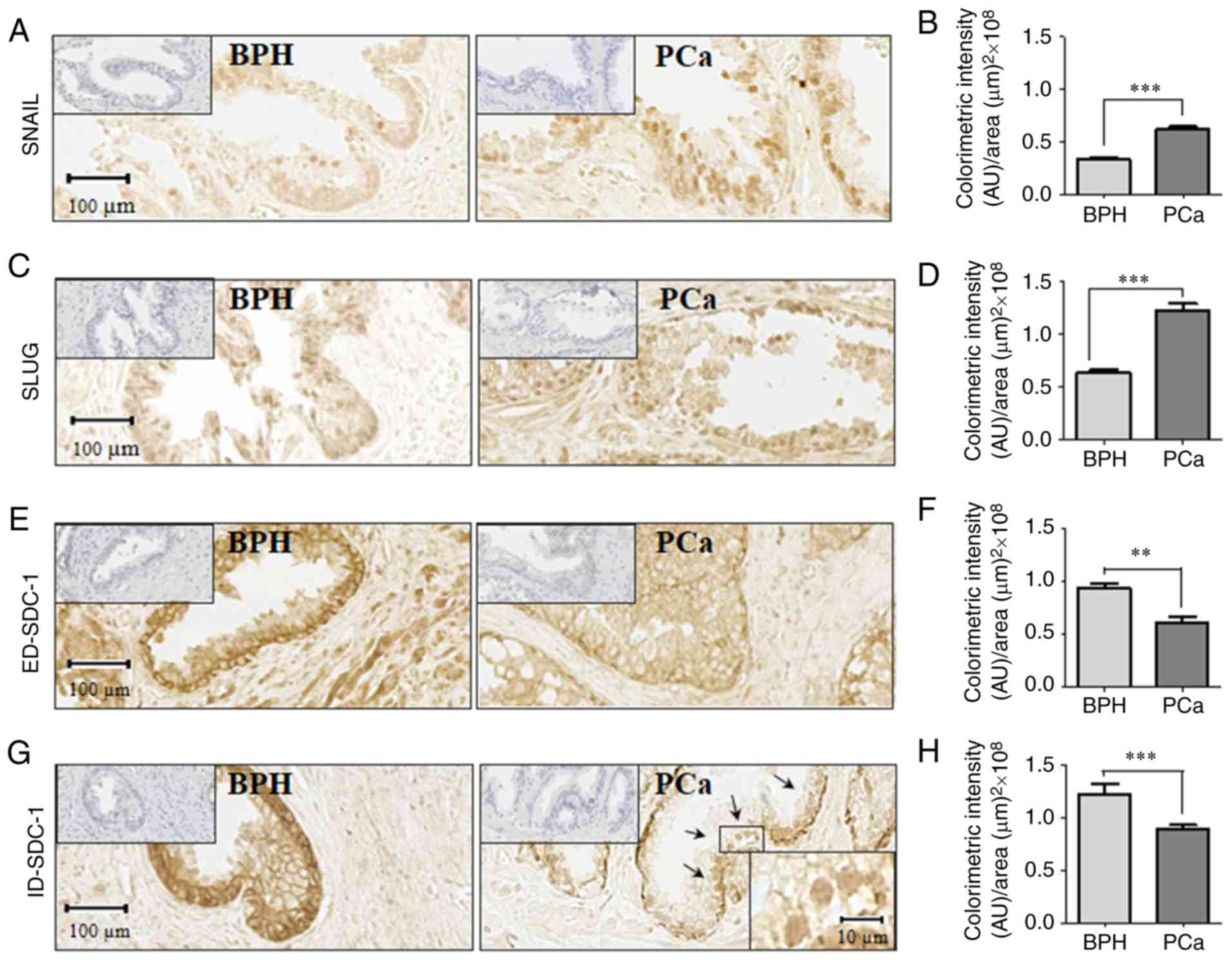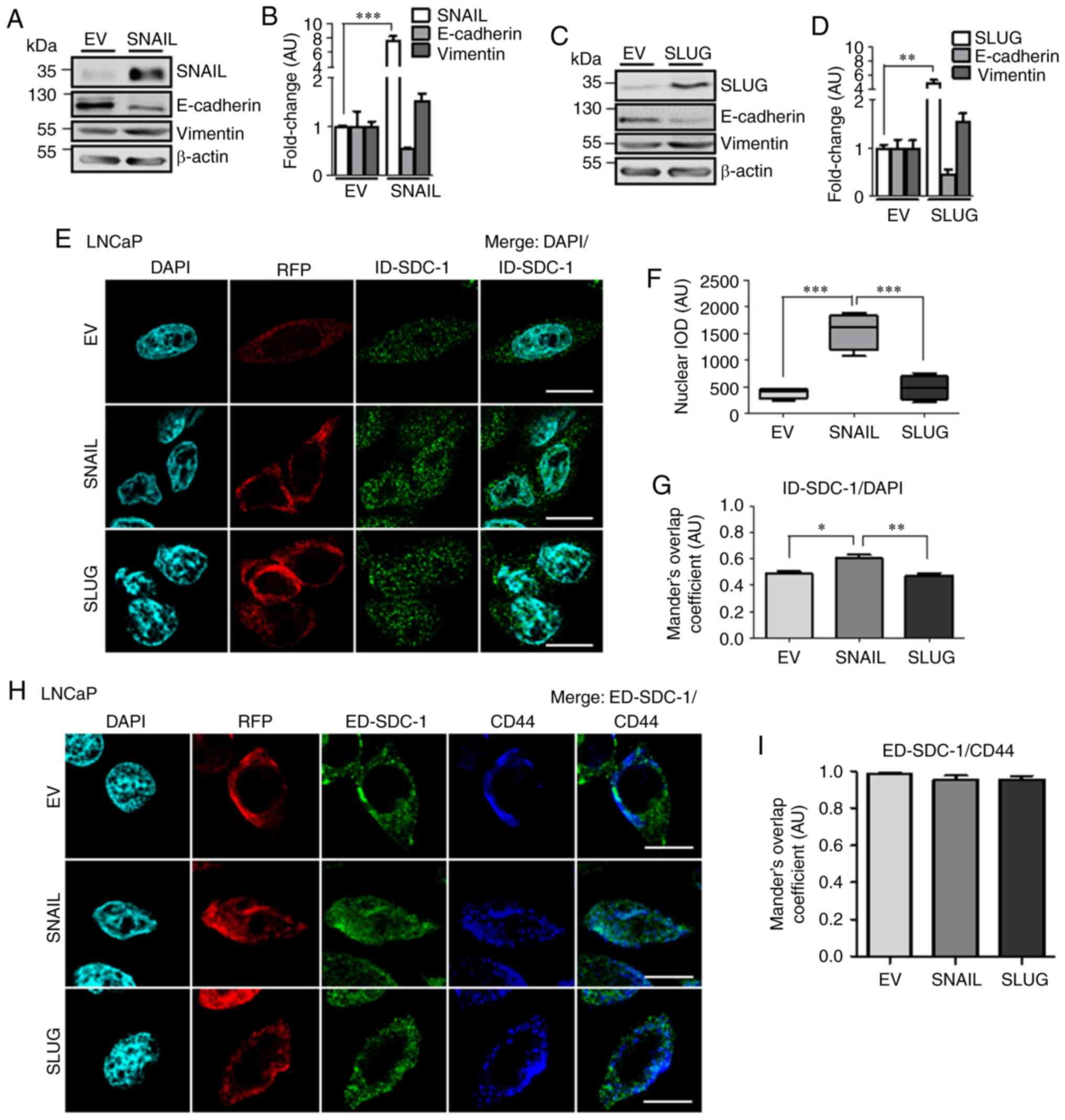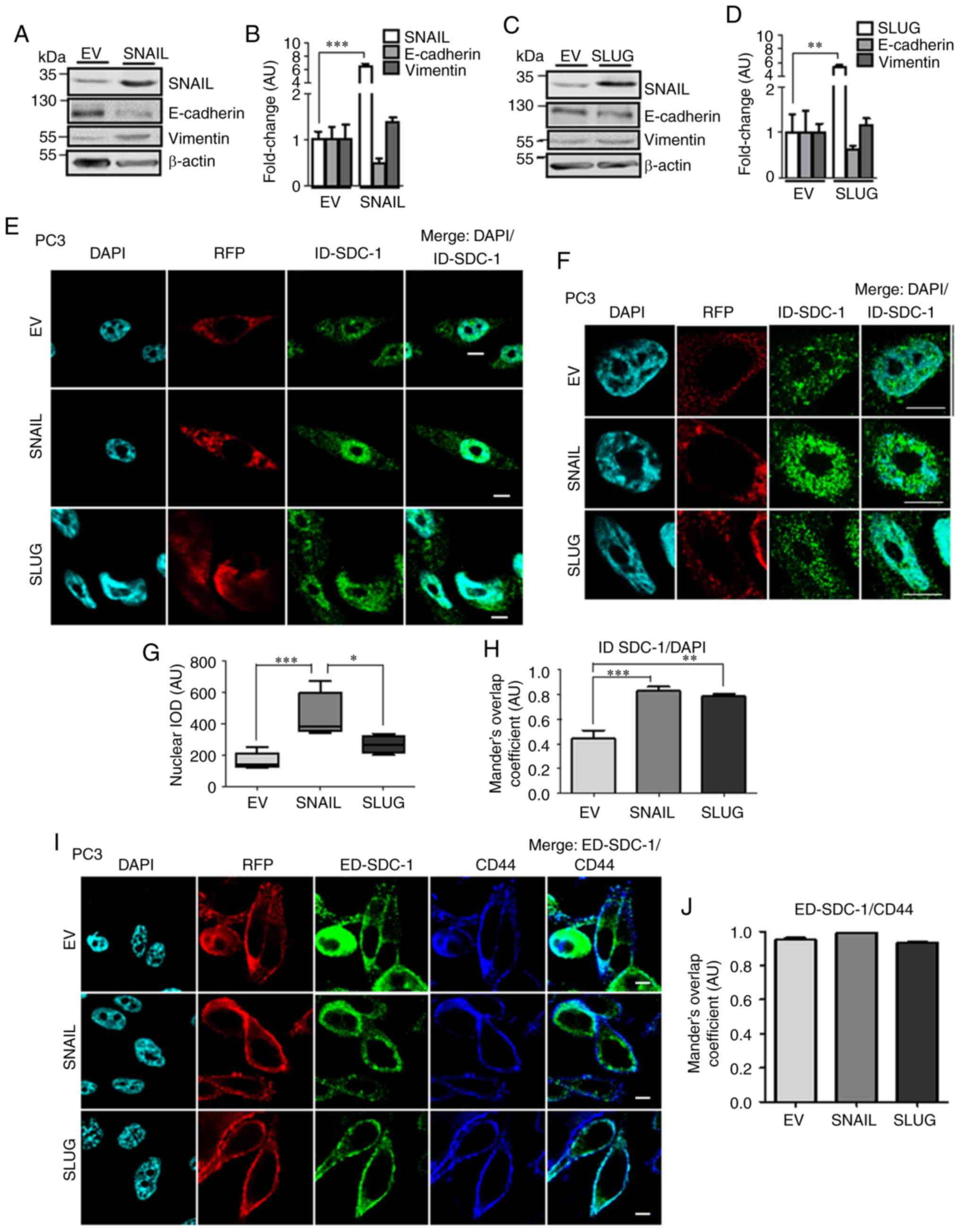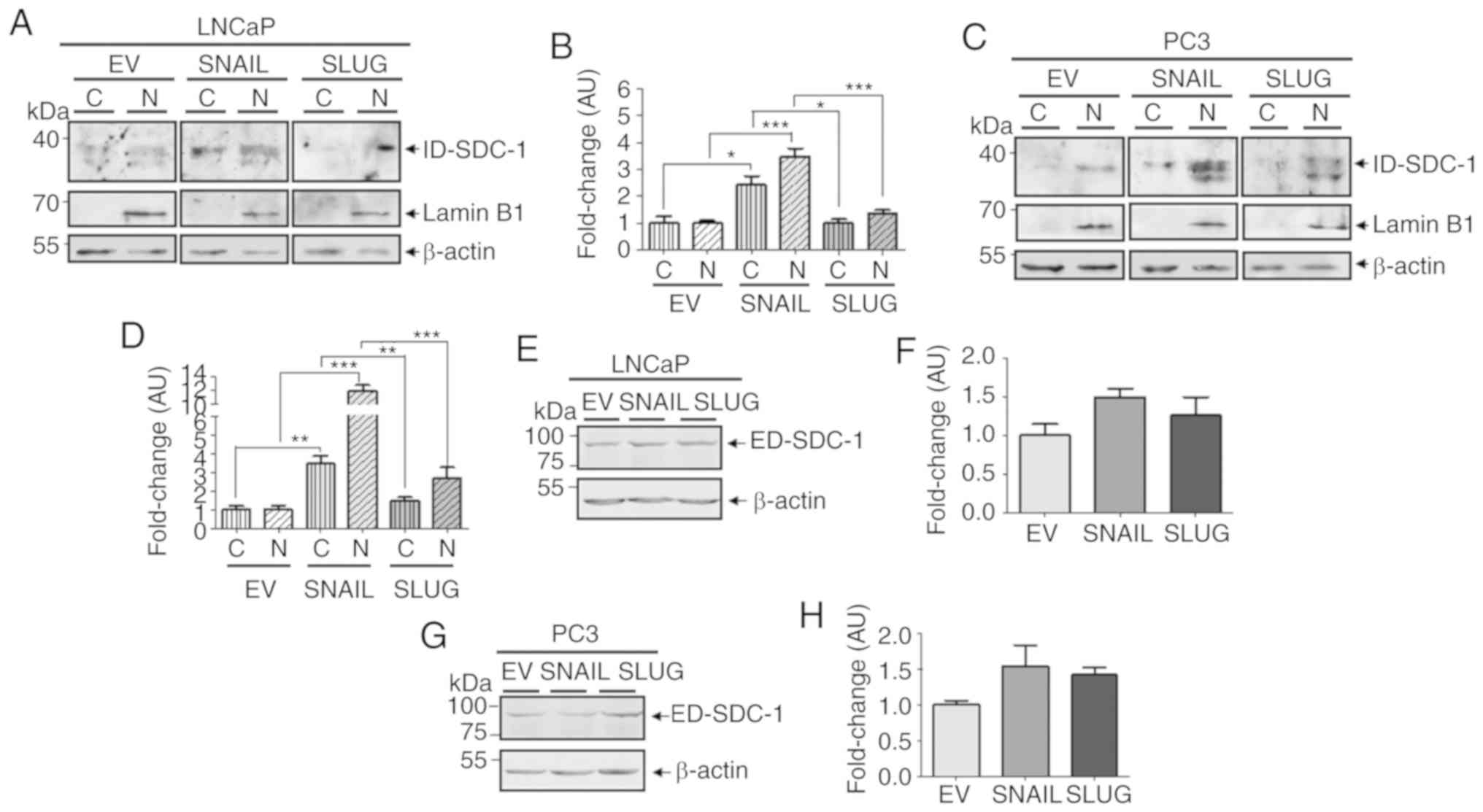|
1
|
Bray F, Ferlay J, Soerjomataram I, Siegel
RL, Torre LA and Jemal A: Global cancer statistics 2018: GLOBOCAN
estimates of incidence and mortality worldwide for 36 cancers in
185 countries. CA Cancer J Clin. 68:394–424. 2018. View Article : Google Scholar : PubMed/NCBI
|
|
2
|
Nieto MA, Huang RY, Jackson RA and Thiery
JP: EMT: 2016. Cell. 166:21–45. 2016. View Article : Google Scholar : PubMed/NCBI
|
|
3
|
Micalizzi DS, Farabaugh SM and Ford HL:
Epithelial-mesenchymal transition in cancer: Parallels between
normal development and tumor progression. J Mammary Gland Biol
Neoplasia. 15:117–134. 2010. View Article : Google Scholar : PubMed/NCBI
|
|
4
|
Puisieux A, Brabletz T and Caramel J:
Oncogenic roles of EMT-inducing transcription factors. Nat Cell
Biol. 16:488–494. 2014. View
Article : Google Scholar : PubMed/NCBI
|
|
5
|
Poblete CE, Fulla J, Gallardo M, Muñoz V,
Castellón EA, Gallegos I and Contreras HR: Increased SNAIL
expression and low syndecan levels are associated with high Gleason
grade in prostate cancer. Int J Oncol. 44:647–654. 2014. View Article : Google Scholar : PubMed/NCBI
|
|
6
|
Contreras HR, Ledezma RA, Vergara J,
Cifuentes F, Barra C, Cabello P, Gallegos I, Morales B, Huidobro C
and Castellón EA: The expression of syndecan-1 and -2 is associated
with Gleason score and epithelial-mesenchymal transition markers,
E-cadherin and beta-catenin, in prostate cancer. Urol Oncol.
28:534–540. 2010. View Article : Google Scholar
|
|
7
|
Ledezma R, Cifuentes F, Gallegos I, Fullá
J, Ossandon E, Castellon EA and Contreras HR: Altered expression
patterns of syndecan-1 and -2 predict biochemical recurrence in
prostate cancer. Asian J Androl. 13:476–480. 2011. View Article : Google Scholar : PubMed/NCBI
|
|
8
|
Dhodapkar MV, Abe E, Theus A, Lacy M,
Langford JK, Barlogie B and Sanderson RD: Syndecan-1 is a
multifunctional regulator of myeloma pathobiology: Control of tumor
cell survival, growth, and bone cell differentiation. Blood.
91:2679–2688. 1998. View Article : Google Scholar : PubMed/NCBI
|
|
9
|
Leppä S, Mali M, Miettinen HM and Jalkanen
M: Syndecan expression regulates cell morphology and growth of
mouse mammary epithelial tumor cells. Proc Natl Acad Sci USA.
89:932–936. 1992. View Article : Google Scholar : PubMed/NCBI
|
|
10
|
Hu Y, Sun H, Owens RT, Gu Z, Wu J, Chen
YQ, O'Flaherty JT and Edwards IJ: Syndecan-1-dependent suppression
of PDK1/Akt/bad signaling by docosahexaenoic acid induces apoptosis
in prostate cancer. Neoplasia. 12:826–836. 2010. View Article : Google Scholar : PubMed/NCBI
|
|
11
|
Tumova S, Woods A and Couchman JR: Heparan
sulfate proteoglycans on the cell surface: Versatile coordinators
of cellular functions. Int J Biochem Cell Biol. 32:269–288. 2000.
View Article : Google Scholar : PubMed/NCBI
|
|
12
|
Brockstedt U, Dobra K, Nurminen M and
Hjerpe A: Immunoreactivity to cell surface syndecans in cytoplasm
and nucleus: Tubulin-dependent rearrangements. Exp Cell Res.
274:235–245. 2002. View Article : Google Scholar : PubMed/NCBI
|
|
13
|
Purushothaman A, Hurst DR, Pisano C,
Mizumoto S, Sugahara K and Sanderson RD: Heparanase-mediated loss
of nuclear syndecan-1 enhances histone acetyltransferase (HAT)
activity to promote expression of genes that drive an aggressive
tumor phenotype. J Biol Chem. 286:30377–30383. 2011. View Article : Google Scholar : PubMed/NCBI
|
|
14
|
Chen L and Sanderson RD: Heparanase
regulates levels of syndecan-1 in the nucleus. PLoS One.
4:e49472009. View Article : Google Scholar : PubMed/NCBI
|
|
15
|
Zong F, Fthenou E, Wolmer N, Hollósi P,
Kovalszky I, Szilák L, Mogler C, Nilsonne G, Tzanakakis G and Dobra
K: Syndecan-1 and FGF-2, but not FGF receptor-1, share a common
transport route and co-localize with heparanase in the nuclei of
mesenchymal tumor cells. PLoS One. 4:e73462009. View Article : Google Scholar : PubMed/NCBI
|
|
16
|
Szatmári T and Dobra K: The role of
syndecan-1 in cellular signaling and its effects on heparan sulfate
biosynthesis in mesenchymal tumors. Front Oncol. 3:3102013.
View Article : Google Scholar
|
|
17
|
Stewart MD, Ramani VC and Sanderson RD:
Shed syndecan-1 translocates to the nucleus of cells delivering
growth factors and inhibiting histone acetylation: A novel
mechanism of tumor-host cross-talk. J Biol Chem. 290:941–949. 2015.
View Article : Google Scholar :
|
|
18
|
Bernfield M, Götte M, Park PW, Reizes O,
Fitzgerald ML, Lincecum J and Zako M: Functions of cell surface
heparan sulfate proteoglycans. Annu Rev Biochem. 68:729–777. 1999.
View Article : Google Scholar
|
|
19
|
Kovalszky I, Hjerpe A and Dobra K: Nuclear
translocation of heparan sulfate proteoglycans and their functional
significance. Biochim Biophys Acta. 1840:2491–2497. 2014.
View Article : Google Scholar : PubMed/NCBI
|
|
20
|
Farfán N, Ocarez N, Castellón EA, Mejía N,
de Herreros AG and Contreras HR: The transcriptional factor ZEB1
represses Syndecan 1 expression in prostate cancer. Sci Rep.
8:114672018. View Article : Google Scholar : PubMed/NCBI
|
|
21
|
Herrera D, Orellana-Serradell O, Villar P,
Torres MJ, Paciucci R, Castellón EA and Contreras HR: Silencing of
the transcriptional factor ZEB1 alters the steroidogenic pathway,
and increases the concentration of testosterone and DHT in DU145
cells. Oncol Rep. 41:1275–1283. 2019.
|
|
22
|
Fortini ME: Gamma-secretase-mediated
proteolysis in cell-surface-receptor signalling. Nat Rev Mol Cell
Biol. 3:673–684. 2002. View
Article : Google Scholar : PubMed/NCBI
|
|
23
|
Anido J, Scaltriti M, Bech Serra JJ,
Santiago Josefat B, Todo FR, Baselga J and Arribas J: Biosynthesis
of tumorigenic HER2 C-terminal fragments by alternative initiation
of translation. EMBO J. 25:3234–3244. 2006. View Article : Google Scholar : PubMed/NCBI
|
|
24
|
Solovei I, Thanisch K and Feodorova Y: How
to rule the nucleus: Divide et impera. Curr Opin Cell Biol.
40:47–59. 2016. View Article : Google Scholar : PubMed/NCBI
|
|
25
|
Millanes-Romero A, Herranz N, Perrera V,
Iturbide A, Loubat-Casanovas J, Gil J, Jenuwein T, García de
Herreros A and Peiró S: Regulation of heterochromatin transcription
by Snail1/LOXL2 during epithelial-to-mesenchymal transition. Mol
Cell. 52:746–757. 2013. View Article : Google Scholar : PubMed/NCBI
|
|
26
|
Céspedes MV, Larriba MJ, Pavón MA, Alamo
P, Casanova I, Parreño M, Feliu A, Sancho FJ, Muñoz A and Mangues
R: Site-dependent E-cadherin cleavage and nuclear translocation in
a metastatic colorectal cancer model. Am J Pathol. 177:2067–2079.
2010. View Article : Google Scholar : PubMed/NCBI
|
|
27
|
Chetty R, Serra S and Asa SL: Loss of
membrane localization and aberrant nuclear E-cadherin expression
correlates with invasion in pancreatic endocrine tumors. Am J Surg
Pathol. 32:413–419. 2008. View Article : Google Scholar : PubMed/NCBI
|


















